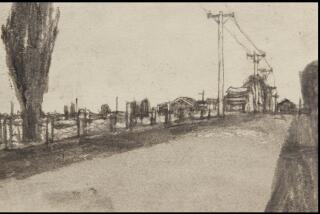Just mad about Basil Wolverton
- Share via
Cartoonist Basil Wolverton’s biomorphic caricatures are anything but pretty. But that didn’t stop him from becoming one of the most influential cartoonists of the 1960s underground comix movement -- a movement that included Robert Williams, Art Spiegelman and Robert Crumb. In recognition of that influence, the Grand Central Art Center in Santa Ana is hosting a retrospective featuring more than 100 Wolverton originals.
In addition to numerous self-explanatory caricatures like “Triangle Head” and “Chicklets Teeth,” the exhibition also includes examples of his early comic-book work from the 1930s; his “Powerhouse Pepper” humor feature, published in Timely, Marvel and Humorama comics; as well as an assortment of rejected and commissioned pieces.
“Basil Wolverton is an artist who basically shook up the norm and opened the door to some really gritty and wild stuff,” says Grand Central Art Center Director Andrea Harris-McGee. “It’s all drawn so well, and even the ones that are just portraits are so complex . . . that they keep you interested for a long time.”
All the art in the show was culled from the collection of Glenn Bray, who also provided many of the Harvey Kurtzman originals shown last year at the MOCA part of the “Masters of American Comics” exhibition.
Bray’s obsession with Wolverton’s art began in the 1950s at the age of 9, when he opened up a copy of Mad No. 11 and a saw a pickle-nosed troglodyte with three arms, protruding ears and three veiny, bulging eyes.
“I had never seen Basil’s work before, and I had never seen anything so horrific yet so comical,” he recalls. “It took comic art to a whole new level for me.”
It wasn’t until 1970 that Bray finally met Wolverton and began purchasing his original artwork. Over the next several years, Bray picked up early comic-book work, unused art, published pieces that were randomly sent back from publishers and even commissions, in which his sole instruction was to create images “as extreme as possible.”
Although Wolverton’s grotesque but humorous images seem to be the product of a twisted mind, Bray says Wolverton was anything but: “He was everything you’d hope him to be -- he was funny, he was unassuming and he was surprised that anyone would really like his work.”
As it turns out, Bray wasn’t the only one smitten by Wolverton’s work. “When I saw this stuff as a young kid, his art just festered in my mind and later affected my art as I became a serious artist,” says lowbrow legend Robert Williams. “When I got involved with Zap Comix in the late ‘60s and got involved with the other underground artists and discussed Basil with them, I soon came to realize that his pollination had spread enormously.”
Though Wolverton never met with much mainstream commercial success during his lifetime (he died in 1978), Harris-McGee hopes this exhibition will help bring him back into the mainstream consciousness.
“Basil is gone and no longer with us, but his work is still with us. It’s strong, and we feel like he’s deserving of the narrative of being with the ranks of the best illustrators and artists,” she says. “It’s a really wonderful coming out for us and the art world, and it shows curators what else can be shown at a museum.”
--
The Original Art of Basil Wolverton
From the collection of Glenn Bray
Where: Grand Central Art Center, 125 N. Broadway, Santa Ana
When: 11 a.m. to 4 p.m. Sundays, Tuesdays and Thursdays; 11 a.m. to 9 p.m. Fridays and Saturdays; closed Mondays. Through Nov. 11.
Price: Free
Contact: (714) 567-7233, www.grandcentralartcenter.com
More to Read
The biggest entertainment stories
Get our big stories about Hollywood, film, television, music, arts, culture and more right in your inbox as soon as they publish.
You may occasionally receive promotional content from the Los Angeles Times.










